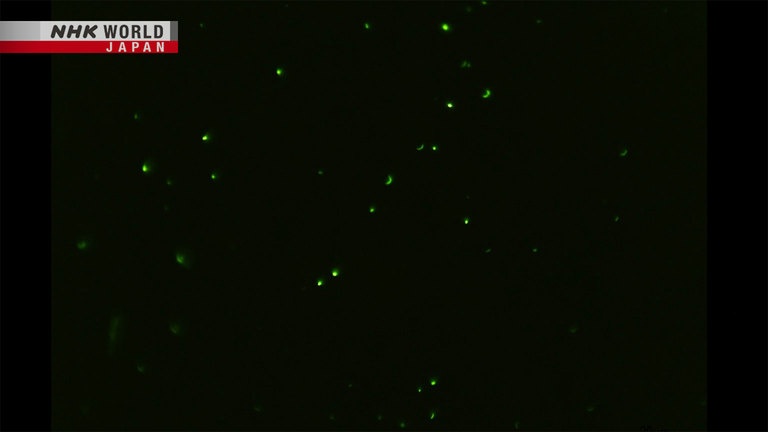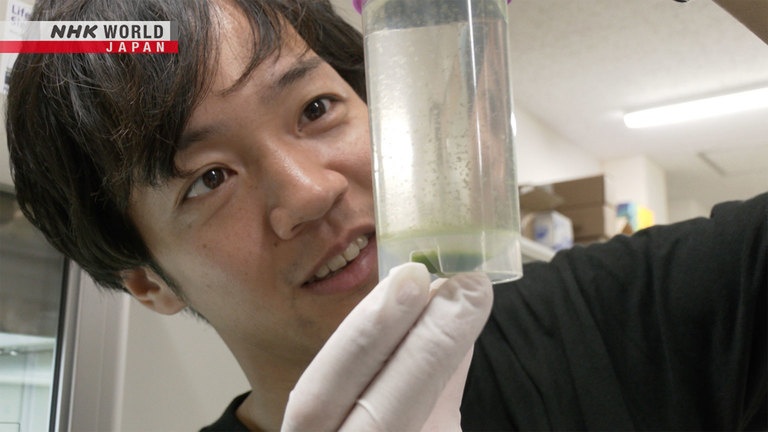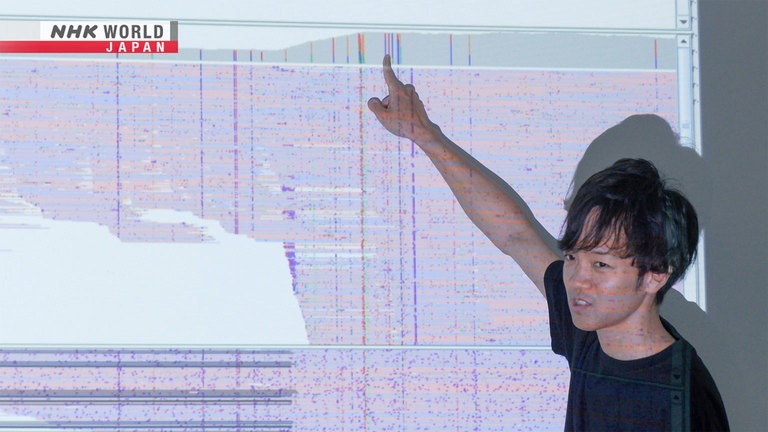Exposing the Bacterial Enigma of the Lake - Microbial Ecologist Yusuke OKAZAKI
Microorganisms are said to be the earliest existing lifeforms on Earth, and a vital part of maintaining its ecosystems. However, because of the difficulty in identifying their function due to their microscopic size, less than 10% of microorganisms have been named and identified. Microbial ecologist Dr. Yusuke OKAZAKI is performing research on the waters of Lake Biwa, where a C-shaped bacteria known as CL500-11 appears at especially high concentrations in its depths. To solve its mysteries, he must succeed in the difficult task of isolating it from other bacteria found in the lake, and growing it separately. In addition, he uses a new method called metagenomic analysis to gain a greater understanding of the lake's ecosystem as a whole.




Transcript
Lake Biwa, the largest lake in Japan.
With a shore length of 235 km, it's known for its abundant water.
Within it, a variety of organisms thrive, comprising a rich ecosystem.
These are newly born fish.
And when the waters are examined even more closely...
The diverse shapes and sizes of plankton can be seen throughout.
These microorganisms play an essential role in maintaining the lake's ecosystem.
But there are residents of the lake that are even tinier still: Bacteria.
These are the bacteria found in Lake Biwa.
The number in the lake is estimated to be 2.75 times 10 to the 22nd power,
1/100th the number of stars in the universe.
However, for most of these bacteria, their form and function remain an enigma.
One researcher was drawn into the vast expanses of the lake's microscopic realm.
His name is Yusuke Okazaki.
This is a colony I'm raising right now.
Okazaki utilizes experiments raising bacteria and high-tech data analysis of the organisms to bring the normally invisible life forms into view.
We still don't really know
what their functions are.
Their sheer number is astounding,
and I'd like to know why.
Just 100 ml of the lake's water teems with over 100 million bacteria.
In this episode, we pursue the function behind their existence.
At the bank of Lake Biwa is a pier used by Kyoto University.
In order to carry out research on microbial lifeforms, Okazaki regularly sets out from here by boat.
I'm checking to make sure it shuts.
Pressing this should shut it.
We're off.
Today, they set sail some 40 minutes into the lake, to a surveillance point with a depth of 74 m.
After passing under the bridge from the shallower southern section of the lake,
the waters soon grow vast and deep.
Lake Biwa is said to have attained its distinctive shape around 400,000 years ago.
Throughout its long history, a variety of life flourished in and around the lake.
Even now, it supports the livelihoods of people in the region.
The ship has reached the surveillance point.
Ready.
First, they check the water temperature.
The sunlight only warms the water
near the surface.
That's why there's a shift in temperature
at the depths.
The bacteria I'm targeting are more common
here in the deeper water.
They're ready to obtain the sample.
Okazaki is aiming for water at a depth of 50 m.
In order to glimpse the conditions of the lake, the device has been fitted with an underwater camera.
Near the surface, the lake water is a verdant green.
The color shows that the water is rich in phytoplankton.
Past a depth of 15 m, as the light dims, the levels of phytoplankton become noticeably thinner.
From around 30 m, the waters are plunged into total darkness.
Here, the temperature is just 8 or 9 degrees Celsius year-round.
Okazaki is attempting to grasp the workings of the bacteria that occupy these depths.
He drops the weight to close the cannister.
I can't wait to see it.
It's at a depth of 50 meters?
The catch is made!
It's cold. Just 8 degrees.
I'll rinse it off.
We can't expose the bacteria to light.
For the deep water, the bacteria
are growing very quickly.
Gathering bacteria in the process of growth
should make it easier for us to raise them.
This was just the right season.
Okazaki returns to the lab to see what he's reeled in.
Let's check out the deep sample.
I'll adjust the focus.
There they are.
Beautiful!
I found them again.
This is the best.
See, here? And here.
The life that had been submerged at 50 m is now visible to the naked eye.
Thousands of bacteria are gathered, each just 1/500th of a millimeter large.
I love looking at them.
There it is. It's a little faint.
Okazaki is especially intrigued by the bacteria shaped like the letter C.
These are Chloroflexi, a phylum that is often reactive to light.
This one is the CL500-11.
It was given this designation after being discovered in the American Crater Lake at a depth of 500 m.
Okazaki was the first to come across them in Lake Biwa.
In his surveys ranging through all of Japan,
he confirmed the presence of the bacteria in deep lake water at more than 10 separate locations.
He further discovered these microorganisms in deep Alpine lakes in Switzerland and Italy.
Other researchers found them in lakes across the globe.
There are lots of them, both in Lake Biwa
and other places as well.
Don't bacteria in such a unique
environment make you curious?
I want to find out what they're doing there.
Okazaki grew up near the seaside in Hiroshima.
Each day after school he would examine the life around the shore,
and soon he held the dream of researching the many fish that filled the ocean waters.
His interest in microorganisms began at university.
Like the plankton consumed by fish, the vital role that unseen creatures play in the natural world became apparent to him.
In graduate school, Okazaki was stationed in a laboratory researching the microorganisms in Lake Biwa.
His supervisor at the time was Shinichi Nakano,
who studies the protists that consume plankton and other matter at the lake's surface.
Where there's light, you have phytoplankton,
photosynthesis occurring, bacteria, protists...
That was the focus of my research,
but Lake Biwa is very deep.
Okazaki felt that we should study what
changes from the surface to the depths.
As he was progressing with that,
he came across the bacteria.
I had looked at each of them, and drawn
their shapes.It's funny to see now.
As a grad student, Okazaki spent each day diligently sketching out the largely unexplored bacteria that lived deep in the lake.
It was during this time that he came across the C-shaped bacteria.
With two years of research, he succeeded in pinpointing their identity as CL500-11.
Then, he delved even further into their unique characteristics.
This graph charted the monthly increases and decreases in CL500-11 concentration.
It demonstrated that the bacteria increase steadily from June, reaching peak levels in November.
At the time, the lab had been accumulating data from another project examining the lake's lower waters.
In it, they discovered something that corresponded to the shifts in CL500-11.
The green data charts the CL500-11.
The orange shows the amount of organic matter that remains in the waters, such as the material that is hard for bacteria to consume.
The blue is levels of protists like flagellates, which eat bacteria.
The data shows that all of these organisms increase in the depths around the same season.
The recalcitrant dissolved organic matter is difficult
to consume, so the CL500-11 eat it very slowly.
Interestingly, we realized that the bacteria-eating
kinetoplastid flagellates in turn feed on them.
We thought that even in these depths,
each of these organisms must be vying for survival.
It's only a theory, but it was fascinating to me.
From spring through autumn, as the surface water is heated by sunlight and made lighter in weight,
the lake is divided into two water layers.
It seemed that hidden in the deep waters of the lake,
the tiny organisms such as protists and bacteria had made their own unique ecosystem, as Nakano theorized.
In the winter, the surface water becomes colder and heavier, causing mass to sink and complete the full cycle.
It's speculated that with this, nutrition created through the deep-water food web is spread throughout the lake,
contributing to the stability of its ecosystem.
However, this still leaves the mystery of what role CL500-11 may play within the system as a whole.
It's numerous and large, in terms of biomass.
Understanding what they do and
what happens to their cells is likely to be
the key to understanding this deep-water
ecosystem and food web.
I think the ultimate approach is to
grow and research the bacteria.
In order to grasp the specifics of the bacteria, the type needs to be isolated and allowed to replicate.
Okazaki sets about trying to extract solely the CL500-11 he gathered from Lake Biwa.
This machine counts the number of bacteria found in water.
These are their numbers in deep water.
In just 1 ml of water, around 1 million bacteria are detected.
They're incredibly dense.
The sample is then diluted to 1/3000th of its former concentration in order to reduce the cell density.
They're clustered at a density
of 3.3 per 10 microliters.
So if we spread 10 microliters per well,
there'd be an average of 3 in each.
The sample is placed in the medium, and then the waiting for growth begins.
I think it's very likely that some wells
contain only CL500-11.
The levels are high right now, so 10%
in the depths of the lake may be CL500-11.
Whether it grows is a matter of luck,
so we just have to play the numbers.
It's a gamble, and if we're lucky,
one of the samples will grow.
Okazaki takes the opportunity to check the progress of a bacteria culture he began a month ago.
Some of the samples take months
to reach a testable state.
It's hard to achieve growth with those.
Without knowing what CL500-11 consumes or the speed of its lifecycle, growing it is a challenging task.
When a shape appears ringed in a blue line, it indicates the growth of some form of bacteria.
I can't see it. Doesn't look promising.
Wait. Here's some growth.
Among all the bacterial samples, around 10% show growth.
The size is noticeable.
CL500-11 may show up here.
There's a chance.
He checks to see if the increasing bacteria is indeed CL500-11.
There isn't much growth.
Chances don't look good.
It would've been great if there were
C-shaped bacteria, but they're
the normally appearing round ones.
Even the most likely among them
didn't show signs of growth.
This is a daunting task.
All we can do is repeat the process
until we come up with results.
Foreign researchers are also at work on it,
so they might achieve it first.
But I'd like to be the first, after reporting
that there were so many in the lake.
Honestly, who knows if I'll pull it off?
An entire ecosystem hidden beneath Lake Biwa...
But with the microscopic size of bacteria, means to judge their types and movements are limited.
Currently, a bold new method to comprehend the ecosystem from a different viewpoint is under development: Metagenomic analysis.
It extracts and analyzes DNA from the microorganisms in the lake as a whole.
Okazaki is using the method to grasp just how many kinds of bacteria may exist in the lake.
This is DNA harvested from bacteria
in Lake Biwa.
The sample indicates the DNA of more than 1 billion distinct bacteria.
Using the process, Okazaki was able to successfully identify the genomic data of bacteria from the lake.
The left column shows bacterium types.
A total of 575 have been positively confirmed.
The data provides a detailed window not just into the varieties of bacteria, but also their presence in the water by month.
This is the metagenomic data for CL500-11.
Examining it reveals the mutations in each individual nucleotide.
The thicker blocks of color indicate the mutated nucleotides.
There aren't any mutations to this
16SrRNA ribosome.
Genes necessary for building the proteins required to maintain life lack lines in this gray strip,
but the neighboring gene is marked with numerous colorful lines.
This is a transporter gene, which is used
to import or export materials.
You can see here that there are
many mutations occurring in it.
The analysis reveals not only nucleotide mutation, but also insertion or deletion of genes,
which is an important event in microbial genome evolution.
Mapping the DNA shows the position
of nucleotides being changed, and mutations.
The actual diversity of microorganisms
in the lake must be even greater.
Lake Biwa alone has this variety, so it could
be compared to other lakes in terms of diversity.
Or you could see how evolution has diverged,
and more detailed analysis could use the information.
I'd like to take the approach of examining the lake
with high-resolution metagenomes.
He hopes he'll be able to compare genomic data spanning entire lakes,
revealing the mysteries of their habitats and evolution.
On his days off, Okazaki occasionally makes a visit to the Lake Biwa Museum to admire local fish.
I love staring at a single fish,
wondering what it's up to.
Owing to the length of Lake Biwa's existence, a number of endemic species inhabit its waters.
These fish live only in the depths
of Lake Biwa.
I bet that when they were caught, they had
the microorganisms I research all over them.
Whether Lake Biwa boasts its own unique microorganisms remains to be seen.
I'm sure there must be lots of
undiscovered types.
You can recognize fish at first glance,
but microorganisms need DNA analysis.
Looking at all the genomes through high
resolution, we might find them in Lake Biwa.
It'd be an exciting discovery.
Okazaki's fascination with the world of microorganisms runs just as deep as the lake itself.